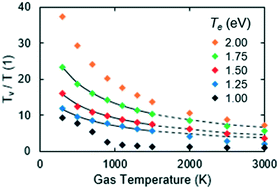The behavior and modelling of the vibrational-to-translational temperature ratio at long time scales in CO2 vibrational kinetics†
Abstract
Non-thermal microwave plasma reactors can efficiently split the CO2 molecule. However, big challenges remain before this technology can become a feasible industrial technology. Computer modelling can be very useful to tackle such challenges. Detailed kinetic modelling is commonly used to gain insights into the complex vibrational kinetics of CO2, as vibrational excitation is strongly related to the energy efficiency in the dissociation process. The vibrational-to-translational temperature ratio has been identified as a key variable to achieve high energy efficiencies. This ratio has also been used to simplify detailed CO2 vibrational kinetics, notably reducing the number of species and reactions required to model the non-thermal plasma. In this paper we use an isothermal reaction kinetics model to study the vibrational kinetics of CO2 under the typical conditions used in non-thermal microwave plasma experiments. The importance of the different collisional processes is evaluated with respect to the different conditions and timescales at which CO2 dissociation takes place. The long timescale behavior of the vibrational-to-translational temperature ratio under different conditions is discussed in detail. It is shown that the behavior at increasing gas temperatures can be fitted to an expression that incorporates the Landau–Teller temperature dependence. This is confirmed by the average adjusted R-square values higher than 0.99 and the average root mean square error values smaller than 0.22 at low gas temperatures. The limitations of the fitting expression are also discussed, especially the conditions and timescales at which it yields better results.



 Please wait while we load your content...
Please wait while we load your content...